Genetic Adaptation by Dengue Virus Serotype 2 to Enhance Infection of Aedes aegypti Mosquito Midguts
Abstract
1. Introduction
2. Methods and Materials
2.1. Cell Culture and Viruses
2.2. Assay of Virus Growth Kinetics in Cell Culture
2.3. Infectious Virus Titration by 50% Tissue Culture Infectious Dose
2.4. Aedes aegypti Mosquito Oral Infection by Artificial Blood-Meal
2.5. DENV2 Passage in Aedes aegypti Mosquito Midguts
2.6. Indirect Immunofluorescence Assay (IFA) of Mosquito Tissues
2.7. Envelope Glycoprotein Gene Sequencing
3. Results
3.1. Serial Passage of DENV2 in Aedes aegypti Mosquito Midguts
3.2. Verification of Adaptation-Mutant Phenotype by Site-Directed Mutagenesis to Construct E Protein DII Mutant Viruses
3.3. Phenotypic Properties of E Protein DII Mutants in Ae. aegypti Mosquitoes
4. Discussion
Author Contributions
Funding
Institutional Review Board Statement
Informed Consent Statement
Data Availability Statement
Conflicts of Interest
Author Disclaimer
References
- Bhatt, S.; Gething, P.W.; Brady, O.J.; Messina, J.P.; Farlow, A.W.; Moyes, C.L.; Drake, J.M.; Brownstein, J.S.; Hoen, A.G.; Sankoh, O.; et al. The global distribution and burden of dengue. Nature 2013, 496, 504–507. [Google Scholar] [CrossRef] [PubMed]
- MacKenzie, J.S.; Gubler, D.J.; Petersen, L.R. Emerging flaviviruses: The spread and resurgence of Japanese encephalitis, West Nile and dengue viruses. Nat. Med. 2004, 10, S98–S109. [Google Scholar] [CrossRef]
- Kyle, J.L.; Harris, E. Global Spread and Persistence of Dengue. Annu. Rev. Microbiol. 2008, 62, 71–92. [Google Scholar] [CrossRef] [PubMed]
- Normile, D. Safety concerns derail dengue vaccination program. Science 2017, 358, 1514–1515. [Google Scholar] [CrossRef] [PubMed]
- Mercado-Curiel, R.F.; Esquinca-Avilés, H.A.; Tovar, R.; Díaz-Badillo, Á.; Camacho-Nuez, M.; Muñoz, M.D.L. The four serotypes of dengue recognize the same putative receptors in Aedes aegypti midgut and Ae. albopictus cells. BMC Microbiol. 2006, 6, 85. [Google Scholar] [CrossRef]
- Mercado-Curiel, R.F.; Black, W.C.; Muñoz, M.D.L. A dengue receptor as possible genetic marker of vector competence in Aedes aegypti. BMC Microbiol. 2008, 8, 118. [Google Scholar] [CrossRef] [PubMed]
- Richardson, J.; Black, W.; Salazar, M.I.; Molina-Cruz, A. Quantitative Analysis of Dengue-2 Virus RNA During the Extrinsic Incubation Period in Individual Aedes aegypti. Am. J. Trop. Med. Hyg. 2006, 74, 132–141. [Google Scholar] [CrossRef]
- Salazar, M.I.; Richardson, J.H.; Sánchez-Vargas, I.; Olson, K.E.; Beaty, B.J. Dengue virus type 2: Replication and tropisms in orally infected Aedes aegypti mosquitoes. BMC Microbiol. 2007, 7, 9. [Google Scholar] [CrossRef]
- Kuhn, R.J.; Zhang, W.; Rossmann, M.G.; Pletnev, S.V.; Corver, J.; Lenches, E.; Jones, C.T.; Mukhopadhyay, S.; Chipman, P.R.; Strauss, E.G.; et al. Structure of Dengue Virus: Implications for Flavivirus Organization, Maturation, and Fusion. Cell 2002, 108, 717–725. [Google Scholar] [CrossRef]
- Modis, Y.; Ogata, S.; Clements, D.; Harrison, S.C. A ligand-binding pocket in the dengue virus envelope glycoprotein. Proc. Natl. Acad. Sci. USA 2003, 100, 6986–6991. [Google Scholar] [CrossRef]
- Heinz, F.X. Epitope Mapping of Flavivirus Glycoproteins. Adv. Virus Res. 1986, 31, 103–168. [Google Scholar] [PubMed]
- Mandl, C.W.; Guirakhoo, F.; Holzmann, H.; Heinz, F.X.; Kunz, C. Antigenic structure of the flavivirus envelope protein E at the molecular level, using tick-borne encephalitis virus as a model. J. Virol. 1989, 63, 564–571. [Google Scholar] [CrossRef] [PubMed]
- Roehrig, J.; Bolin, R.A.; Kelly, R.G. Monoclonal Antibody Mapping of the Envelope Glycoprotein of the Dengue 2 Virus, Jamaica. Virology 1998, 246, 317–328. [Google Scholar] [CrossRef]
- Roehrig, J.; Johnson, A.J.; Hunt, A.R.; Bolin, R.A.; Chu, M.C. Antibodies to dengue 2 virus E-glycoprotein synthetic peptides identify antigenic conformation. Virology 1990, 177, 668–675. [Google Scholar] [CrossRef]
- Erb, S.M.; Butrapet, S.; Moss, K.J.; Luy, B.E.; Childers, T.; Calvert, A.E.; Silengo, S.J.; Roehrig, J.T.; Huang, C.Y.-H.; Blair, C.D. Domain-III FG loop of the dengue virus type 2 envelope protein is important for infection of mammalian cells and Aedes aegypti mosquitoes. Virology 2010, 406, 328–335. [Google Scholar] [CrossRef] [PubMed]
- Fansiri, T.; Fontaine, A.; Diancourt, L.; Caro, V.; Thaisomboonsuk, B.; Richardson, J.H.; Jarman, R.G.; Ponlawat, A.; Lambrechts, L. Genetic Mapping of Specific Interactions between Aedes aegypti Mosquitoes and Dengue Viruses. PLoS Genet. 2013, 9, e1003621. [Google Scholar] [CrossRef]
- Bennett, K.E.; Olson, K.E.; Muñoz, M.D.L.; Fernández Salas, I.; Farfán Ale, J.A.; Higgs, S.; Black, W.C.; Beaty, B.J. Variation in vector competence for dengue 2 virus among 24 collections of Aedes aegypti from Mexico and the United States. Am. J. Trop. Med. Hyg. 2002, 67, 85–92. [Google Scholar] [CrossRef]
- Armstrong, P.M.; Rico-Hesse, R. Efficiency of Dengue Serotype 2 Virus Strains to Infect and Disseminate in Aedes aegypti. Am. J. Trop. Med. Hyg. 2003, 68, 539–544. [Google Scholar] [CrossRef]
- Huang, C.Y.-H.; Butrapet, S.; Moss, K.J.; Childers, T.; Erb, S.M.; Calvert, A.E.; Silengo, S.J.; Kinney, R.M.; Blair, C.D.; Roehrig, J.T. The dengue virus type 2 envelope protein fusion peptide is essential for membrane fusion. Virology 2009, 396, 305–315. [Google Scholar] [CrossRef]
- Butrapet, S.; Childers, T.; Moss, K.J.; Erb, S.M.; Luy, B.E.; Calvert, A.E.; Blair, C.D.; Roehrig, J.; Huang, C.Y.-H. Amino acid changes within the E protein hinge region that affect dengue virus type 2 infectivity and fusion. Virology 2011, 413, 118–127. [Google Scholar] [CrossRef]
- Erb, S.M. Mutagenesis of the dengue virus envelope glycoprotein gene can significantly alter virus infectivity phenotypes in cultured cells and live mosquitoes. In Microbiology, Immunology & Pathology; Colorado State University: Fort Collins, CO, USA, 2011; p. 195. [Google Scholar]
- Huang, C.Y.-H.; Butrapet, S.; Pierro, D.J.; Chang, G.J.J.; Hunt, A.R.; Bhamarapravati, N.; Gubler, D.J.; Kinney, R.M. Chimeric Dengue Type 2 (Vaccine Strain PDK-53)/Dengue Type 1 Virus as a Potential Candidate Dengue Type 1 Virus Vaccine. J. Virol. 2000, 74, 3020–3028. [Google Scholar] [CrossRef] [PubMed][Green Version]
- Halstead, S.B.; Simasthien, P. Observations related to the pathogenesis of dengue hemorrhagic fever. II. Antigenic and biologic properties of dengue viruses and their association with disease response in the host. Yale J. Biol. Med. 1970, 42, 276–292. [Google Scholar] [PubMed]
- Kinney, R.M.; Butrapet, S.; Chang, G.-J.J.; Tsuchiya, K.R.; Roehrig, J.; Bhamarapravati, N.; Gubler, D.J. Construction of Infectious cDNA Clones for Dengue 2 Virus: Strain 16681 and Its Attenuated Vaccine Derivative, Strain PDK-53. Virology 1997, 230, 300–308. [Google Scholar] [CrossRef]
- Deubel, V.; Kinney, R.M.; Trent, D.W. Nucleotide sequence and deduced amino acid sequence of the structural proteins of dengue type 2 virus, Jamaica genotype. Virology 1986, 155, 365–377. [Google Scholar] [CrossRef]
- Deubel, V.; Kinney, R.M.; Trent, D.W. Nucleotide sequence and deduced amino acid sequence of the nonstructural proteins of dengue type 2 virus, Jamaica genotype: Comparative analysis of the full-length genome. Virology 1988, 165, 234–244. [Google Scholar] [CrossRef]
- Pierro, D.J.; Salazar, M.I.; Beaty, B.J.; Olson, K.E. Infectious clone construction of dengue virus type 2, strain Jamaican 1409, and characterization of a conditional E6 mutation. J. Gen. Virol. 2006, 87, 2263–2268. [Google Scholar] [CrossRef]
- Deubel, V.; Kinney, R.M.; Esposito, J.J.; Cropp, C.B.; Vorndam, A.V.; Monath, T.P.; Trent, D.W. Dengue 2 Virus Envelope Protein Expressed by a Recombinant Vaccinia Virus Fails to Protect Monkeys against Dengue. J. Gen. Virol. 1988, 69, 1921–1929. [Google Scholar] [CrossRef]
- BButrapet, S.; Kinney, R.M.; Huang, C.Y.-H. Determining genetic stabilities of chimeric dengue vaccine candidates based on dengue 2 PDK-53 virus by sequencing and quantitative TaqMAMA. J. Virol. Methods 2006, 131, 1–9. [Google Scholar] [CrossRef]
- Reed, L.J.; Muench, H. A Simple Method of Estimating Fifty Per Cent Endpoints. Am. J. Epidemiol. 1938, 27, 493–497. [Google Scholar] [CrossRef]
- Brackney, D.E.; Olson, K.E.; Foy, B. The Effects of Midgut Serine Proteases on Dengue Virus Type 2 Infectivity of Aedes aegypti. Am. J. Trop. Med. Hyg. 2008, 79, 267–274. [Google Scholar] [CrossRef]
- Zhang, X.; Sheng, J.; Plevka, P.; Kuhn, R.J.; Diamond, M.S.; Rossmann, M.G. Dengue structure differs at the temperatures of its human and mosquito hosts. Proc. Natl. Acad. Sci. USA 2013, 110, 6795–6799. [Google Scholar] [CrossRef] [PubMed]
- Hung, J.-J.; Hsieh, M.-T.; Young, M.-J.; Kao, C.-L.; King, C.-C.; Chang, W. An External Loop Region of Domain III of Dengue Virus Type 2 Envelope Protein Is Involved in Serotype-Specific Binding to Mosquito but Not Mammalian Cells. J. Virol. 2004, 78, 378–388. [Google Scholar] [CrossRef] [PubMed]
- Prestwood, T.R.; Prigozhin, D.M.; Sharar, K.L.; Zellweger, R.M.; Shresta, S. A Mouse-Passaged Dengue Virus Strain with Reduced Affinity for Heparan Sulfate Causes Severe Disease in Mice by Establishing Increased Systemic Viral Loads. J. Virol. 2008, 82, 8411–8421. [Google Scholar] [CrossRef] [PubMed]
- Kinoshita, H.; Mathenge, E.G.M.; Hung, N.T.; Huong, V.T.Q.; Kumatori, A.; Yu, F.; Parquet, M.C.; Inoue, S.; Matias, R.R.; Natividad, F.F.; et al. Isolation and characterization of two phenotypically distinct dengue type-2 virus isolates from the same dengue hemorrhagic Fever patient. Jpn. J. Infect. Dis. 2009, 62, 343–350. [Google Scholar]
- Roehrig, J.T. Antigenic structure of flavivirus proteins. Adv. Virus Res. 2003, 59, 141–175. [Google Scholar]
- Wahala, W.; Kraus, A.A.; Haymore, L.B.; Accavitti-Loper, M.A.; de Silva, A.M. Dengue virus neutralization by human immune sera: Role of envelope protein domain III-reactive antibody. Virology 2009, 392, 103–113. [Google Scholar] [CrossRef]
- Wang, E.; Ni, H.; Xu, R.; Barrett, A.D.T.; Watowich, S.J.; Gubler, D.J.; Weaver, S.C. Evolutionary Relationships of Endemic/Epidemic and Sylvatic Dengue Viruses. J. Virol. 2000, 74, 3227–3234. [Google Scholar] [CrossRef]
- Twiddy, S.S.; Woelk, C.H.; Holmes, E.C. Phylogenetic evidence for adaptive evolution of dengue viruses in nature. J. Gen. Virol. 2002, 83, 1679–1689. [Google Scholar] [CrossRef]
- Vasilakis, N.; Tesh, R.B.; Durbin, A.P.; Munoz-Jordan, J.L.; Da Rosa, A.P.A.T.; Weaver, S.C. Antigenic relationships between sylvatic and endemic dengue viruses. Am. J. Trop. Med. Hyg. 2008, 79, 128–132. [Google Scholar] [CrossRef]
- Vasilakis, N.; Fokam, E.B.; Hanson, C.T.; Weinberg, E.; Sall, A.A.; Whitehead, S.S.; Hanley, K.A.; Weaver, S.C. Genetic and phenotypic characterization of sylvatic dengue virus type 2 strains. Virology 2008, 377, 296–307. [Google Scholar] [CrossRef]
- Hanley, K.A.; Nelson, J.T.; Schirtzinger, E.E.; Whitehead, S.S.; Hanson, C.T. Superior infectivity for mosquito vectors contributes to competitive displacement among strains of dengue virus. BMC Ecol. 2008, 8, 1. [Google Scholar] [CrossRef] [PubMed]
- Hang, V.T.T.; Holmes, E.; Veasna, D.; Quy, N.T.; Hien, T.T.; Quail, M.; Churcher, C.; Parkhill, J.; Cardosa, J.; Farrar, J.; et al. Emergence of the Asian 1 Genotype of Dengue Virus Serotype 2 in Viet Nam: In Vivo Fitness Advantage and Lineage Replacement in South-East Asia. PLoS Negl. Trop. Dis. 2010, 4, e757. [Google Scholar] [CrossRef] [PubMed]
- Messer, W.B.; Gubler, D.J.; Harris, E.; Sivananthan, K.; De Silva, A.M. Emergence and Global Spread of a Dengue Serotype 3, Subtype III Virus. Emerg. Infect. Dis. 2003, 9, 800–809. [Google Scholar] [CrossRef] [PubMed]
- Cologna, R.; Armstrong, P.M.; Rico-Hesse, R. Selection for Virulent Dengue Viruses Occurs in Humans and Mosquitoes. J. Virol. 2005, 79, 853–859. [Google Scholar] [CrossRef]
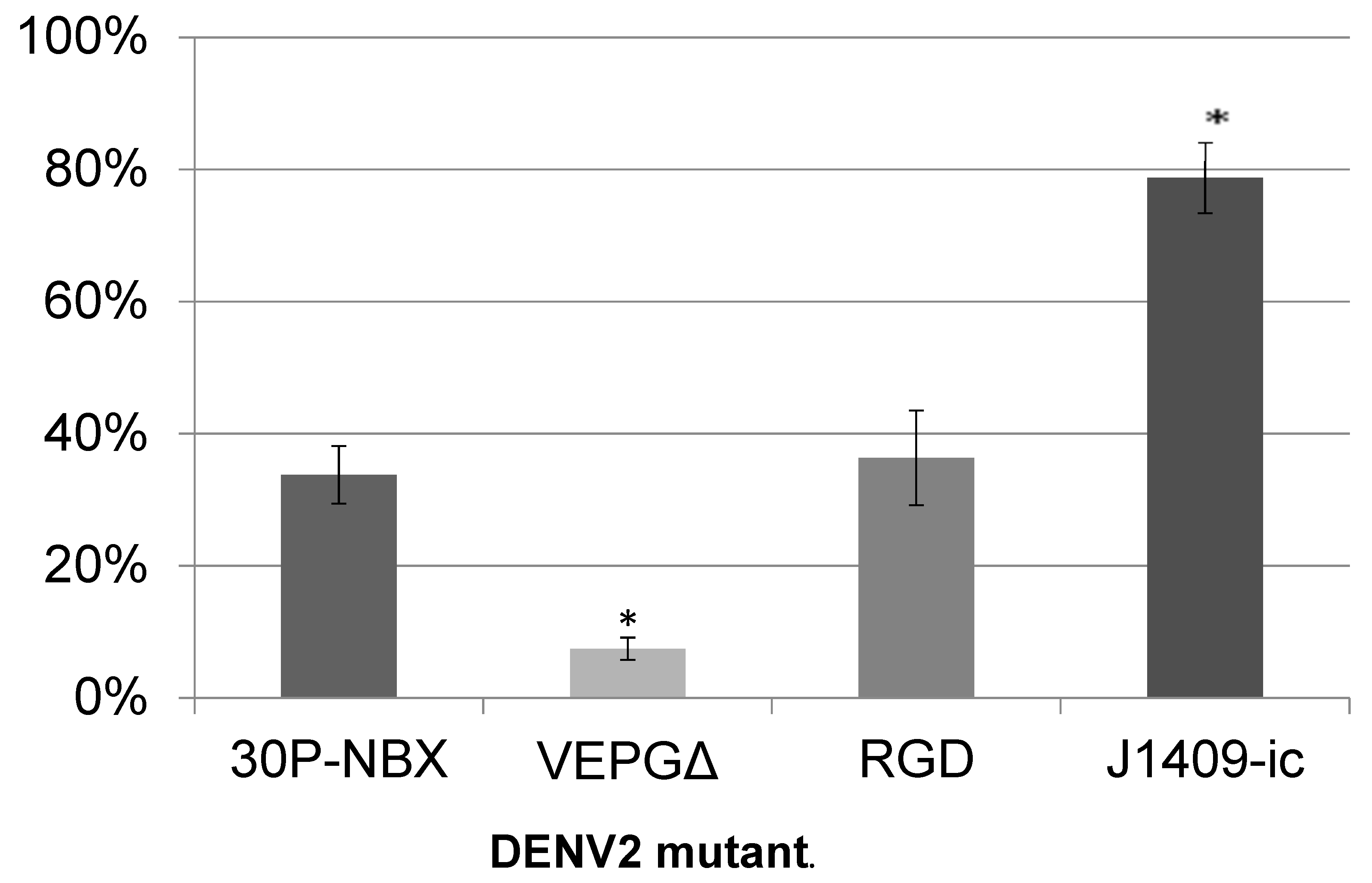
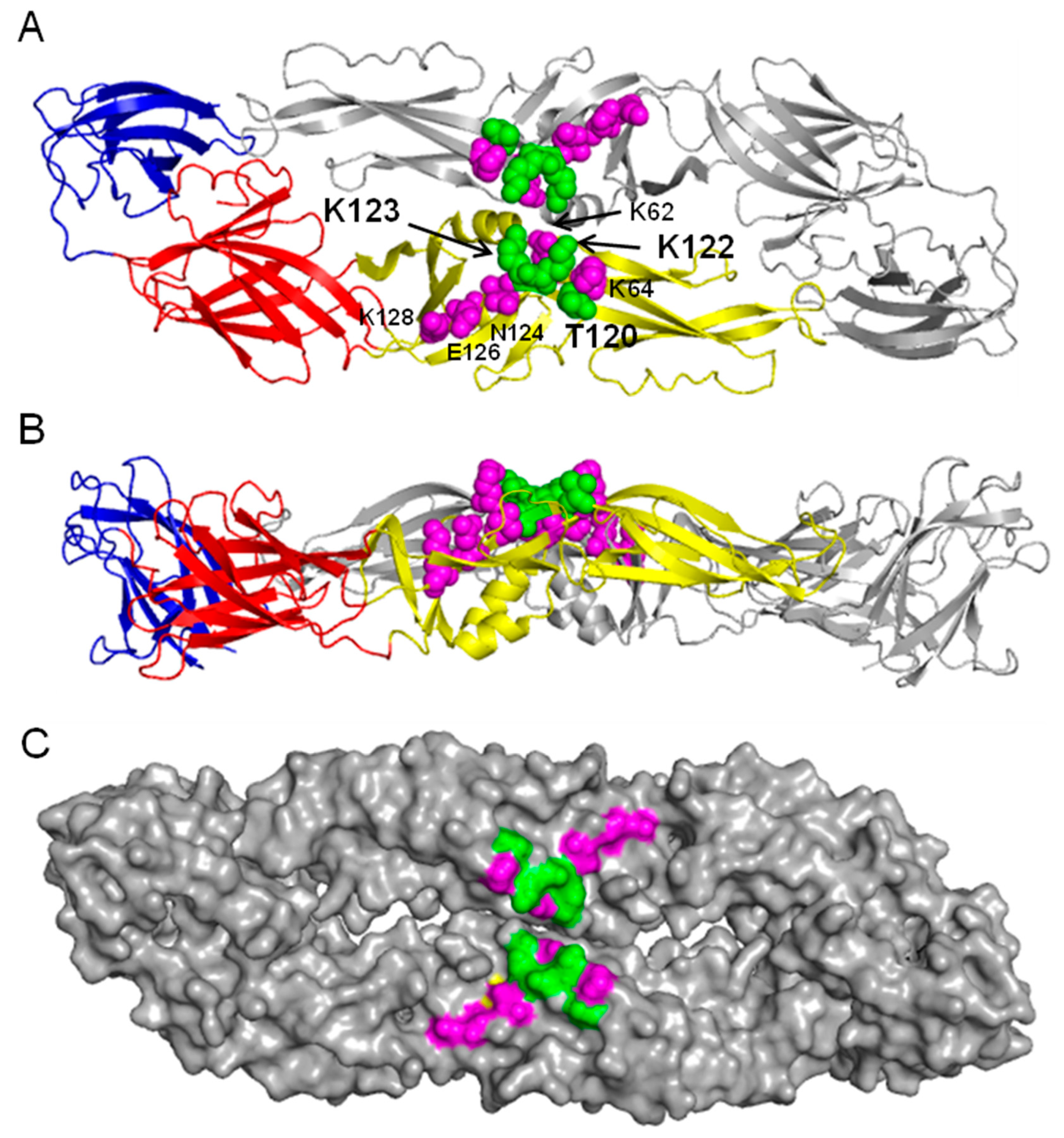
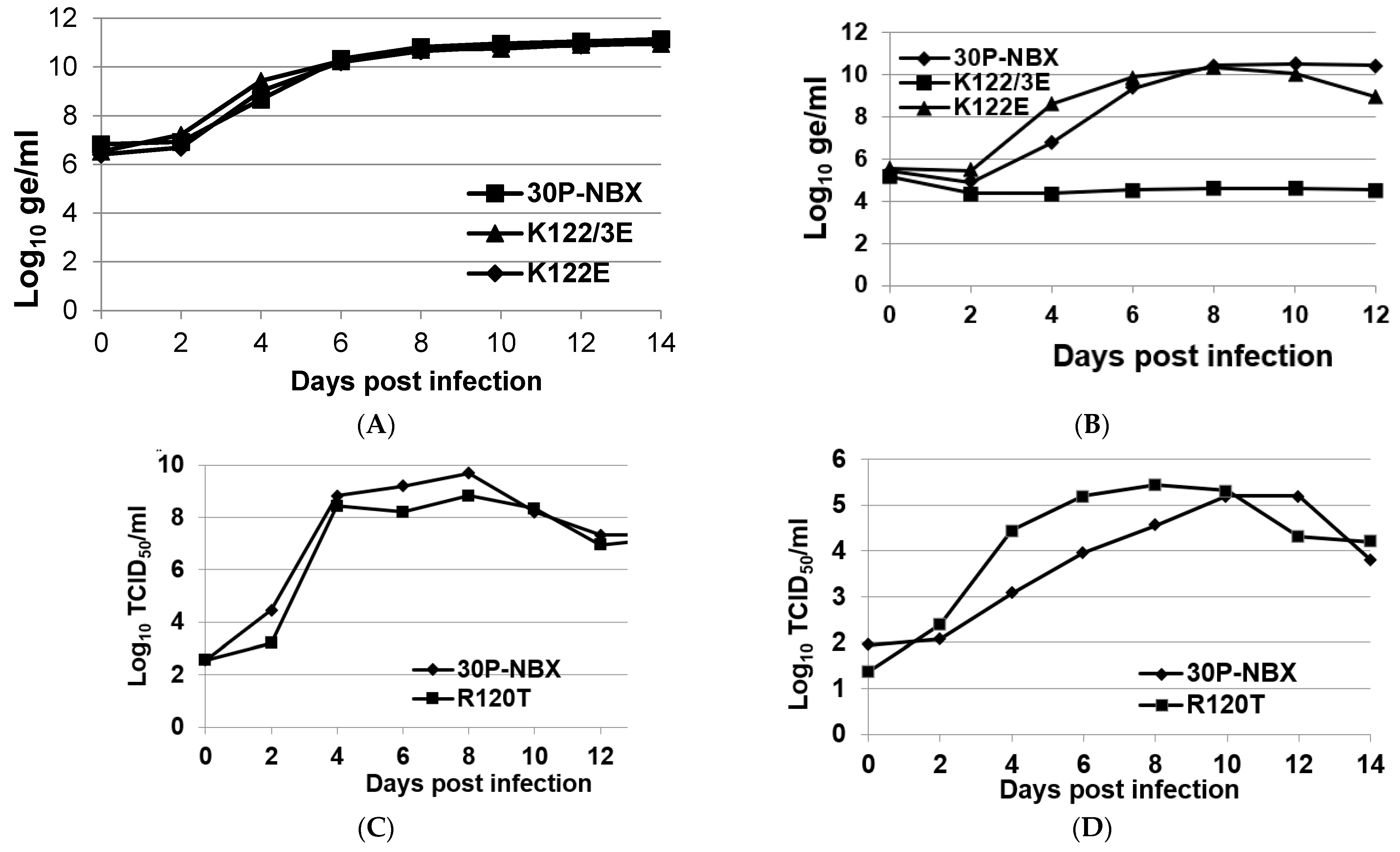
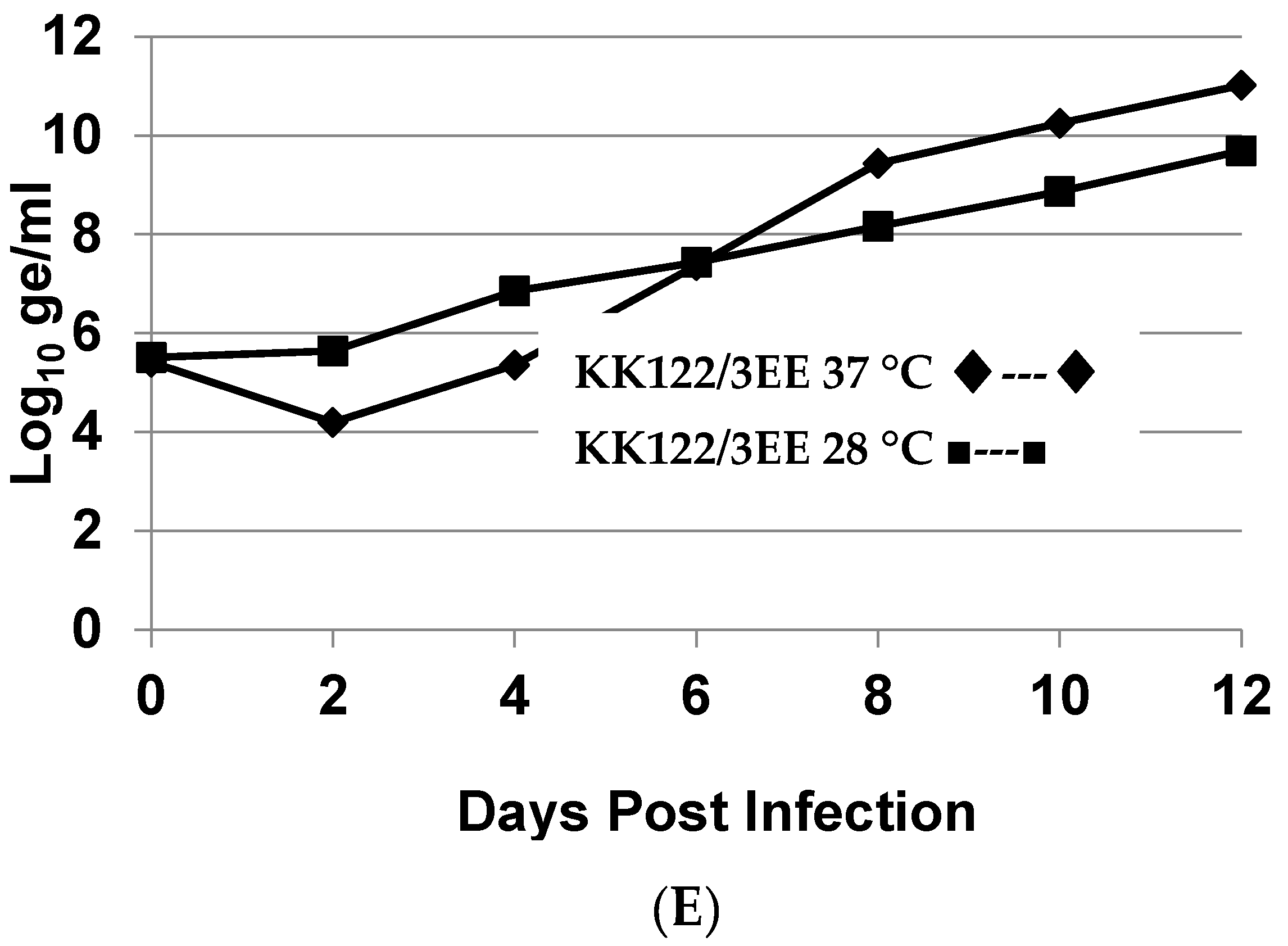
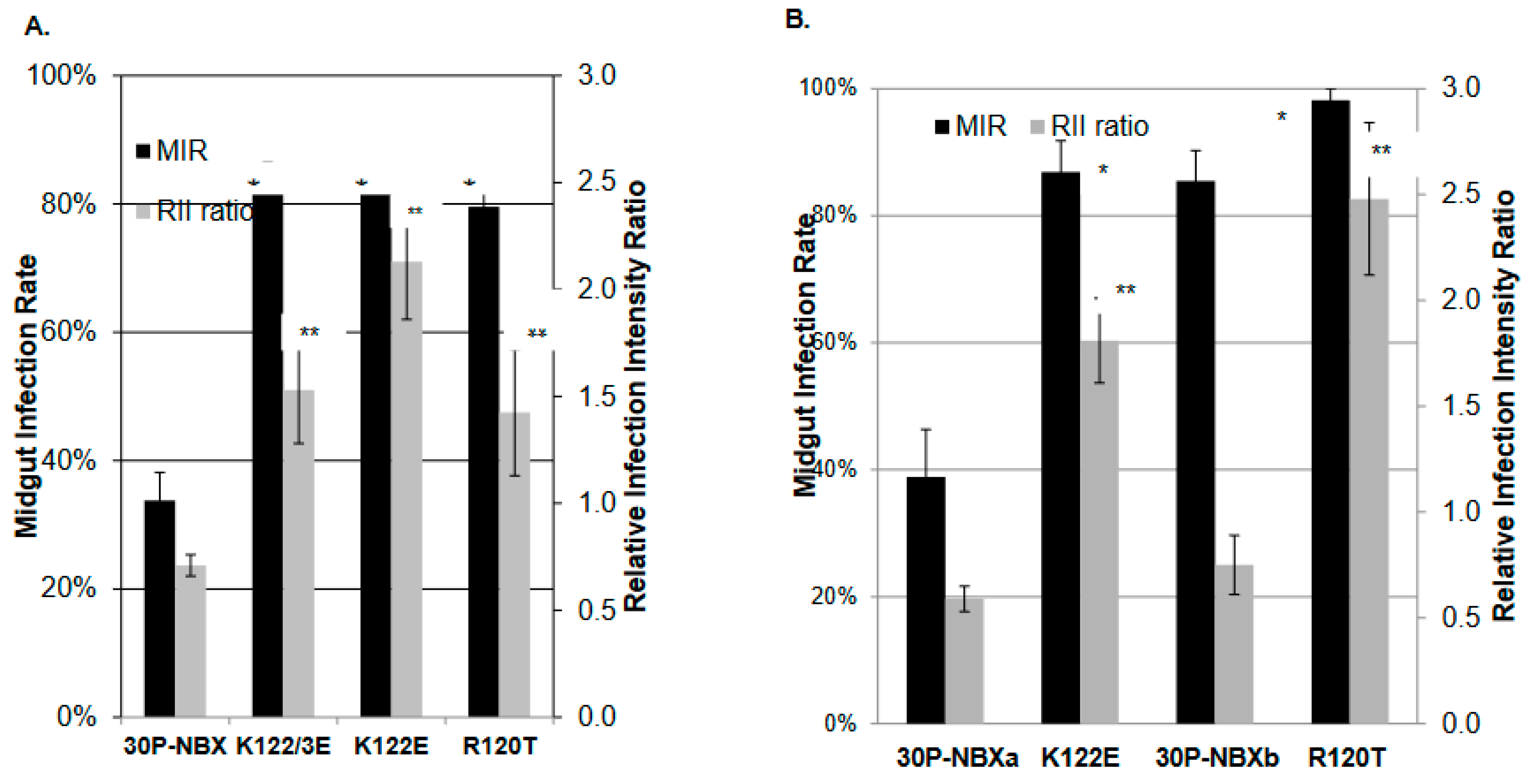
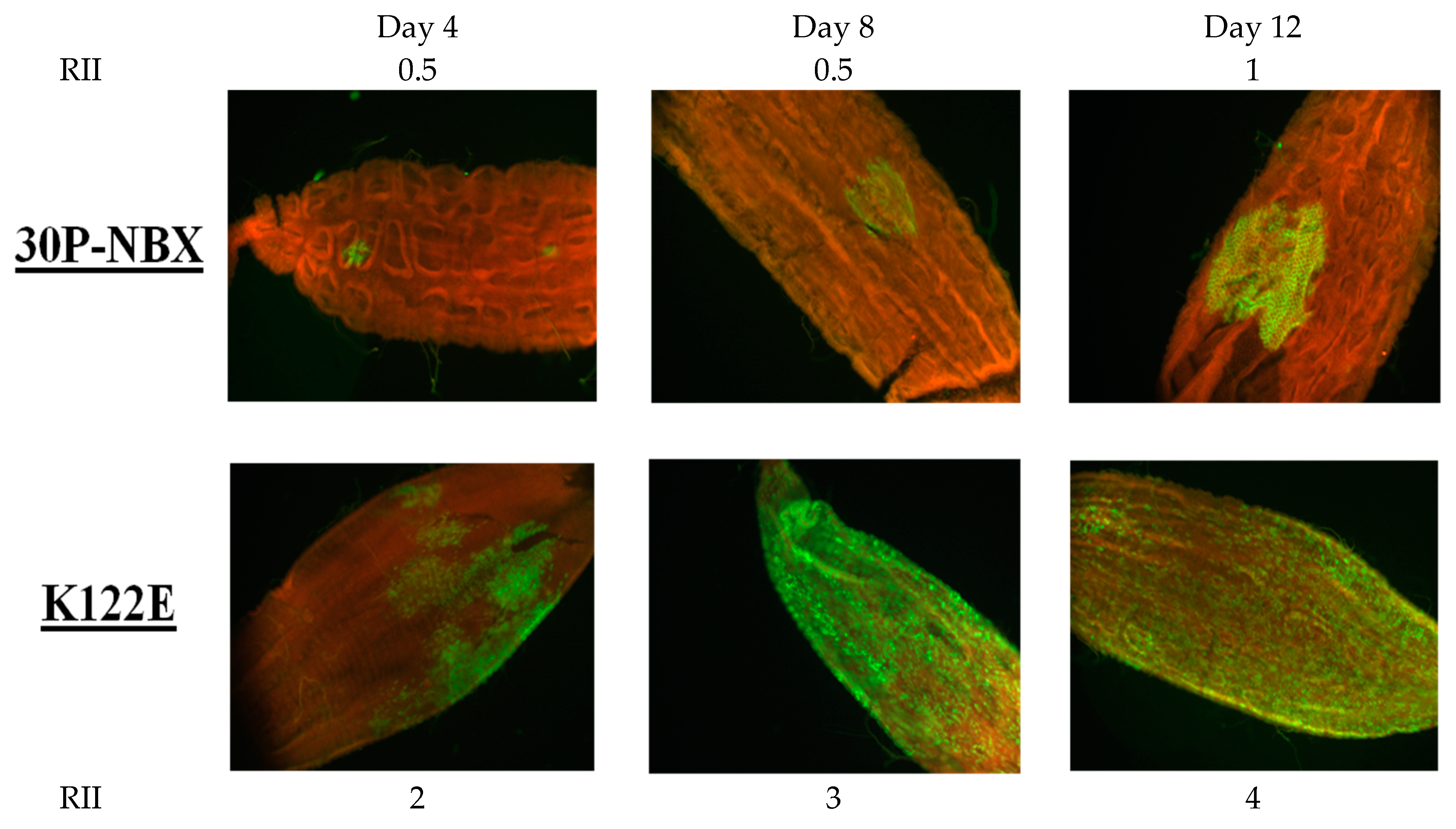
| 30P-NBX | 382VEPGΔ | VEP382RGD | J1409 | |||||||||
|---|---|---|---|---|---|---|---|---|---|---|---|---|
| Passage | Midgut Infection Rate (%) a | Confi-dence Interval (%) | Position 122 AA b | Midgut Infection Rate (%) a | Confi-dence Interval (%) | Position 122 AA b | Midgut Infection Rate (%) a | Confi-dence Interval (%) | Position 122 AA b | Midgut Infection Rate (%) a | Confi-dence Interval (%) | Position 122 AA a |
| 0 | 6/34 (18) | 7–34 | K | 1/24 (4) | 1–20 | K | 11/25 (33) | 20–51 | K | 17/19 (89) | 68–97 | K |
| 1 | 13/19 (68) | 46–86 | K/E | 5/31 (16) | 7–33 | K | 25/30 (83) | 66–93 | K/E | 15/28 (54) | 36–71 | K |
| 2 | 22/36 (61) | 45–75 | E/K | 4/34 (12) | 5–27 | K | 27/29 (93) | 78–98 | E | 22/35 (63) | 46–77 | K |
| 3 | 15/34 (44) | 29–61 | E/K | 1/27 (4) | 0.9–18 | K | 12/21 (57) | 36–76 | E | 24/31 (77) | 60–89 | K |
| 4 | 18/19 (95) | 75–99 | E | 0/35 (0) | 0.07–10 | NA c | 26/30 (87) | 70–95 | E | 25/29 (86) | 69–94 | K |
| Virus | Strain | DENV2 E Glycoprotein AA Position | ||||||||||||||||
|---|---|---|---|---|---|---|---|---|---|---|---|---|---|---|---|---|---|---|
| 116 | 117 | 118 | 119 | 120 | 121 | 122 | 123 | 124 | 125 | 126 | 127 | 128 | 129 | 130 | ||||
| DENV2 Genotypes | ||||||||||||||||||
| Asian 1 | 16681 | C | A | M | F | R | C | K | K | - a | - a | N | M | E | G | K | V | V |
| PUO-218 | T | |||||||||||||||||
| M1 | T | I | ||||||||||||||||
| Asian 2 | New Guin C | T | K | |||||||||||||||
| PL046 | T | I | ||||||||||||||||
| CTD113 | T | K | ||||||||||||||||
| Asian/Amer | Jamaica 1409 | T | ||||||||||||||||
| 13382-Tizimin | T | |||||||||||||||||
| American | PR159 | T | I | |||||||||||||||
| Ven2 | T | I | ||||||||||||||||
| Cosmo | SL714 | T | I | |||||||||||||||
| CAMR5 | T | I | ||||||||||||||||
| Sylvatic | IC80-DAKAr578 | T | L | K | ||||||||||||||
| P8-1407 | T | L | ||||||||||||||||
| Other Mosquito-Borne Flaviviruses | ||||||||||||||||||
| DENV1 | 16007 | K | K | V | T | K | L | I | ||||||||||
| DENV3 | PhMH-J1-97 | K | Q | L | E | S | I | |||||||||||
| DENV4 | Thailand/1985 | K | S | S | G | K | I | T | N | L | ||||||||
| YFV | Asibi | K | A | S | S | L | F | E | ||||||||||
| JEV | Nakayama | K | S | T | S | K | A | I | R | T | I | |||||||
| MVEV | NG156 | K | T | S | S | S | A | A | R | L | I | |||||||
| WNV | NY99 | K | A | S | T | K | A | I | R | T | I | |||||||
| SLEV | Laderle | K | N | K | A | T | T | ! | ||||||||||
| Tick-Borne Flaviviruses | ||||||||||||||||||
| TBEV | Neudoerfl | V | K | A | A | E | A | K | K | K | A | T | H | Y | ||||
| POWV | LB | K | E | E | E | A | K | K | A | V | H | Y | ||||||
| Virus Mutant | C6/36 Cells | Vero Cells | |||
|---|---|---|---|---|---|
| C-0/C-1 a Virus Recovery | C-0/C-1/E Protein Sequence | V-0/V-1 a Virus Recovery | V-0 E Protein Sequence | V-1 E Protein Sequence | |
| KK122/123EE | +/+ | Unchanged b | +/+ | K122 E c, K123K/E part. rev. c | K122 E c, E123K full rev. c |
| R120T | +/+ | Unchanged b | +/+ | Unchanged b | Unchanged b |
Publisher’s Note: MDPI stays neutral with regard to jurisdictional claims in published maps and institutional affiliations. |
© 2022 by the authors. Licensee MDPI, Basel, Switzerland. This article is an open access article distributed under the terms and conditions of the Creative Commons Attribution (CC BY) license (https://creativecommons.org/licenses/by/4.0/).
Share and Cite
Erb, S.M.; Butrapet, S.; Roehrig, J.T.; Huang, C.Y.-H.; Blair, C.D. Genetic Adaptation by Dengue Virus Serotype 2 to Enhance Infection of Aedes aegypti Mosquito Midguts. Viruses 2022, 14, 1569. https://doi.org/10.3390/v14071569
Erb SM, Butrapet S, Roehrig JT, Huang CY-H, Blair CD. Genetic Adaptation by Dengue Virus Serotype 2 to Enhance Infection of Aedes aegypti Mosquito Midguts. Viruses. 2022; 14(7):1569. https://doi.org/10.3390/v14071569
Chicago/Turabian StyleErb, Steven M., Siritorn Butrapet, John T. Roehrig, Claire Y.-H. Huang, and Carol D. Blair. 2022. "Genetic Adaptation by Dengue Virus Serotype 2 to Enhance Infection of Aedes aegypti Mosquito Midguts" Viruses 14, no. 7: 1569. https://doi.org/10.3390/v14071569
APA StyleErb, S. M., Butrapet, S., Roehrig, J. T., Huang, C. Y.-H., & Blair, C. D. (2022). Genetic Adaptation by Dengue Virus Serotype 2 to Enhance Infection of Aedes aegypti Mosquito Midguts. Viruses, 14(7), 1569. https://doi.org/10.3390/v14071569







